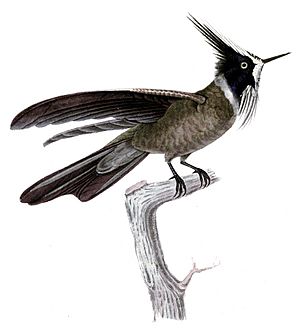White-bearded helmetcrest facts for kids
Quick facts for kids White-bearded helmetcrest |
|
|---|---|
 |
|
| Conservation status | |
| Scientific classification | |
| Genus: |
Oxypogon
|
| Species: |
lindenii
|
 |
|
The white-bearded helmetcrest (Oxypogon lindenii) is a special type of hummingbird. It belongs to a group of hummingbirds called "coquettes." This amazing bird lives only in the northwestern part of Venezuela.
Contents
About the White-bearded Helmetcrest
The white-bearded helmetcrest was once thought to be a kind of bearded helmetcrest. But in 2013, scientists studied these birds very closely. They looked at their size and the colors of their feathers. Because of this study, the white-bearded helmetcrest became its own unique species. It is now known as a "monotypic" species, meaning it is the only one of its kind in its group.
What Does It Look Like?
The white-bearded helmetcrest is about 11.5 centimeters (4.5 inches) long. It weighs around 4.8 grams (0.17 ounces), which is very light! It has a short, straight beak.
Male White-bearded Helmetcrest
The adult male has a cool black and white crest on its head. Its face is mostly black with a wide white "collar" around its neck. Its back and upper parts are a shiny bronzy-green color. It also has a long, thin white "beard" under its chin. The rest of its belly is a dull gray with green spots. Its tail is medium-long and split at the end. The top of its middle tail feathers are olive green. The other tail feathers are dark, but maroon underneath with white lines.
Female and Young White-bearded Helmetcrests
The adult female looks a lot like the male. However, she does not have the crest or the beard. Her belly is a dull white with many greenish-brown spots. Young birds are thought to look like the adult female.
Where Does It Live?
The white-bearded helmetcrest lives only in the Andes mountains of northwestern Venezuela. You can find it in the states of Mérida and Trujillo. It likes to live in wet, high-altitude grasslands called páramo. It especially likes areas with Espeletia plants. Sometimes, it can also be found at the edge of Polylepis forests. Female birds often stay in deep valleys, while males prefer more open areas. These birds live at very high elevations, usually between 3,600 and 4,500 meters (11,800 to 14,800 feet) above sea level.
How It Behaves
Movement
The white-bearded helmetcrest moves from higher páramo areas in the wet season. It goes to lower places when the weather is dry.
Feeding Habits
This hummingbird mostly eats nectar from flowers. It especially loves the nectar from Espeletia schultzii and Castilleja fissifolia plants. Instead of hovering, it often clings to the flowers to drink nectar. It also eats insects and their tiny young (larvae). It catches insects on the ground or by jumping up. Sometimes, it flies out from a perch to catch insects in the air. It also picks larvae off plants.
Reproduction and Life Cycle
The white-bearded helmetcrest's breeding season depends on when the Espeletia flowers bloom. This is usually between June and November. The female builds a large nest using fibers from Espeletia plants. She places the nest in small caves or under overhangs. This keeps the nest safe from the sun and rain. The female lays two eggs. She sits on the eggs for 21 to 23 days until they hatch. The young birds leave the nest about 35 to 38 days after hatching.
Vocalization
The white-bearded helmetcrest has a special song. It is a high-pitched, slightly buzzing sound like "tzee" or "peek." It sings this sound over and over again. During the breeding season, it sings from a perch on a small shrub.
Conservation Status
The IUCN (International Union for Conservation of Nature) says the white-bearded helmetcrest is of "Least Concern." This means it is not currently in danger of disappearing. However, it lives in a very small area. Scientists do not know exactly how many of these birds there are. They believe the number of birds might be going down. Even though it is common and lives in two national parks, too much grazing by animals is a problem there.
See also
 In Spanish: Chivito de páramo para niños
In Spanish: Chivito de páramo para niños


